Hide TV: TV furniture with special effects
Big, flat, 3D – the new television is a gem. But how best to integrate it into the living room? 16 great ideas!
Today’s TV shows are probably no better or worse than before. But streaming services and media libraries are changing television viewing habits. Watching your favorite movies looks twice as fun on the big screen than on the computer. But when turned off, the television is not the prettiest piece of furniture. The clever solution cleverly leaves the television out of sight – and turns it on as soon as your favorite program is playing. Discover TV furniture that swivels, pushes, folds – and be amazed!
- With this TV furniture, designed by some body, you simply turn off the TV and let it disappear into the wall — or more precisely: into a built-in cupboard in an alcove. Black and white contrast with the screen is visible, otherwise – amazing special effects!
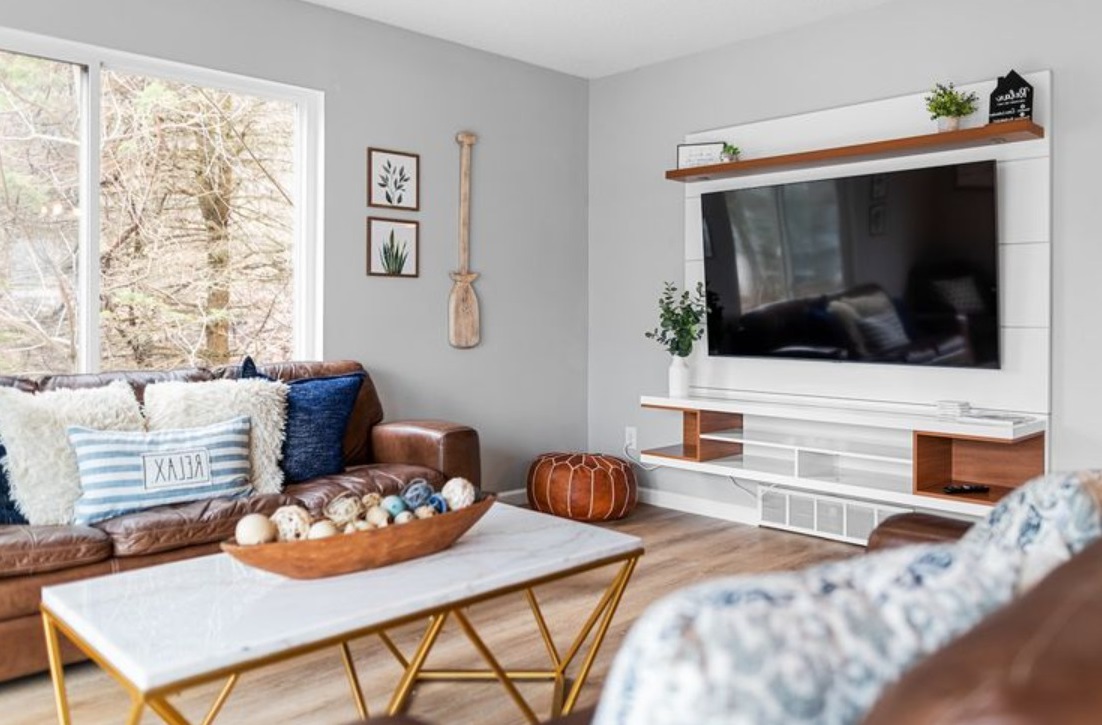
- The same principle of rotation is applied to this slatted wall in the Vgzarquitectos y diseño project. Only two rooms can be used interchangeably with a television – the dining room and the living room. And if you don’t want to see the screen, just flip the cover.
- With this TV and hi-fi block, manufactured by TS Innenausbau from Marl, everything happens with electronic support. This means it can be placed in any position imaginable. There is a hidden CD shelf at the back. When not in use, all that remains is the white walls – in case you want to bring your own imagination to life instead of the world of TV
- In this living room, the interior designers at Despina integrated a television into a custom-made decorative room divider. Above it there is a screen that can be rotated 270 degrees, below it there is a chimney tunnel with views of the fire burning on both sides. Only when you realize that the television is an element of interior design – just like furniture, art or home accessories – do you find smart solutions.
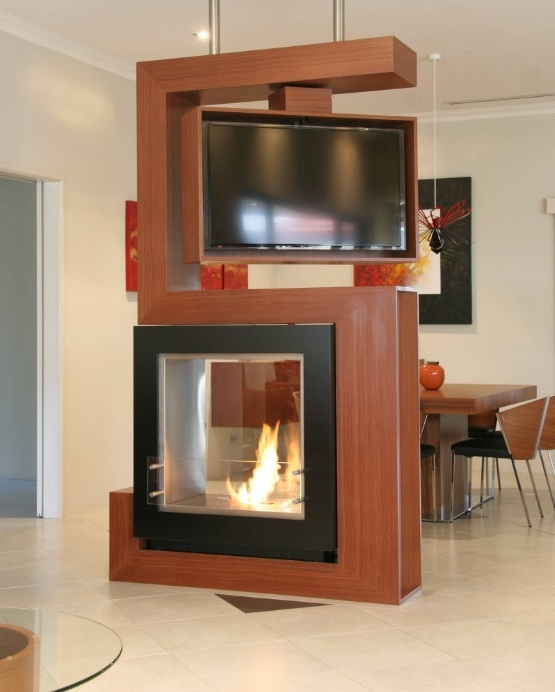
- Looks like the entrance to another room – but behind this barn door panel is a flat screen and matching chest of drawers. This is appropriate: because in a sense television is also a gateway to the world.
- This sliding door made of rugged metal almost reminds you of a safe. But behind that there is “only” a TV and a hi-fi system. The television itself is decorated in a subtle white and wouldn’t stand out too much when mounted on the sloping ceiling, but sliding steel doors eventually shut it off and make the system disappear. Nothing spoils the effect of this room, which is furnished minimalist by interior designer Oliver Wagner.
- This variant is very simple and beautiful in a house in the Cotswolds (England): a flat screen that disappears into a modern cupboard as soon as you close the door. Shut up, dead monkey.
- Here too, the television is hidden in a piece of furniture made especially for it. This is a very classic designed cabinet by Stefan Kornmeier Interior Design and Construction. It visually matches the other furniture in the living room and is therefore stored elegantly.
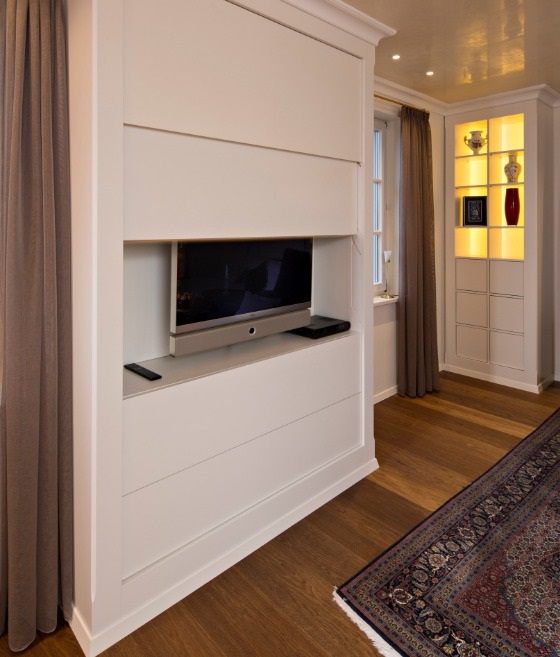
- Televisions are thin: Do you have a beautiful, large-format picture that you want to see instead of a black screen? Then use it as a TV hideaway!
- Out of sight, out of mind. If the TV doesn’t turn on, you can simply close the turnstile in the wall. The integrated wall shelf underneath is certainly a nice addition and takes up less space than a TV cabinet.
- The increasing mechanization of our environment doesn’t stop in the bedroom. Feng Shui and electrical sensitivity clearly oppose televisions and computers near the bed. Ceiling mounts for televisions from Bartels Architektur do not completely solve the problem. But at least the screen doesn’t disturb the impression of the room because it is only left on the suspended ceiling if needed.
- This product made by Die Tischlerei from Aachen is truly a gem. The entire structure – the “Tele-Lift” – can be raised from the ceiling for carefree evening TV viewing. The screen can be rotated 180 degrees – for optimal viewing angles. When pulled up, you can see the ceiling light, which perhaps no one has guessed the secret of its inner workings.
- In a vacation home with a pool designed by Artline from Emmerich, the flat screen is hidden. In the accompanying sideboard, of course, not in the pool. The white cap closes completely at the top. However, if the weather doesn’t allow swimming, you can simply take it back out.
- Clever detail in the large living room of a Hamburg loft apartment: the television can be hidden in a custom-made box. The television can be pulled out and put back in manually. “In this case, manual operation is better than an electrical system, which can fail and suddenly stop working,” says Aimo Aimo, which developed the TV hideaway. The box is padded on the inside so there’s nothing to scratch or even break if the device wobbles a little when you push it inside.
- television? Which TV? This is where color meets function. The wall-mounted TV set visually blends with the black painted walls and therefore fades into the background. The walls become eye-catching – the television is barely visible.
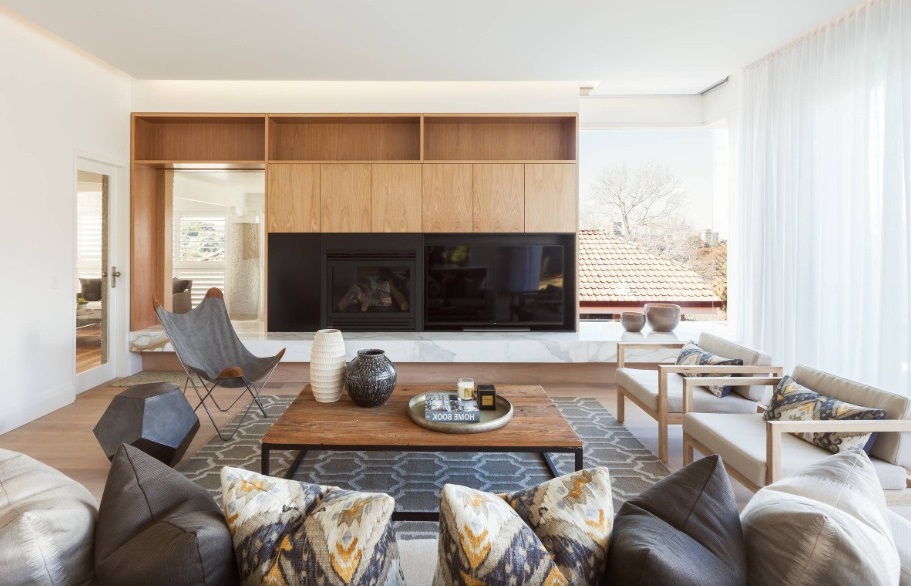
- Search image: On open shelving in a Corben Architects project, a compartment is lined entirely in black. The black screen and fireplace with the same finish can only be glimpsed against this background. The principle: mimicry – analogous to the optical adaptation of animal and plant species to their environment. Large-scale units appear much quieter than dark devices installed individually against a light background.
Maybe we can’t provide illustrative photos for everything, but you can imagine it, right?
How to select the height of your TV stand
When choosing a TV stand, one important factor to consider is the required height, which depends on the TV size and the viewer’s seating arrangement.
Here is a brief guide on determining the appropriate TV and TV stand dimensions and how to assess your living space.
Finding the right TV size
Before selecting a TV stand, it is essential to consider the TV’s size and the seating layout. For an optimal viewing experience, the larger the screen, the further away it should be positioned (and vice versa). This principle applies whether you are optimizing your home theater setup or seeking a stand for a smaller screen.
To determine the required TV size (or seating position), follow these steps:
Measure the distance (in inches) between your seat and where you intend to place the TV
Divide the measurement by 1.6
Round the resulting number to the nearest screen size
For instance, if you are seated 2.5 meters from your TV, this equals 98 inches. Dividing 98” by 1.6 yields 61.25. Therefore, the recommended screen size for your new TV would be 60″. If you already own a 32-inch screen, you may need to move your sofa approximately 40 inches closer.
Optimal TV placement height
Ideally, the middle of the TV screen should align with your eye level. Placing the TV too high or too low can result in neck strain as you tilt your head to view the screen. When seated in your usual viewing position, your neck should remain in a neutral position while watching.
Having this information will make it much easier to choose the perfect height and size for your TV stand. You may find a stand that is the ideal size and height for placing your TV on top. Alternatively, you might realize that wall-mounting your TV allows you to select a smaller, more discreet stand for your other devices.
TV stands that offer extra features
Now that you understand the available space, let’s move on to the enjoyable part – planning the layout! How do you envision your ideal TV setup? Are you considering a substantial, sturdy piece of furniture to support a large TV? Or do you imagine a lightweight, wall-mounted unit?
Floor-based TV stands
When it comes to floor-based TV stands, we offer a variety of styles and designs to suit your preferences. A unit with visible legs can be a stylish addition to your decor if its colors and materials complement other elements in the room. Meanwhile, a legless stand can provide a more cohesive look to the room, as the absence of legs creates an uninterrupted visual flow. Both types of units offer storage solutions and can support the weight of larger TVs.
Wall-mounted stands
A wall-mounted TV stand creates a sleek and minimalist appearance. It also makes cleaning easier since you can easily sweep or vacuum underneath it. However, it is important to consider the type of wall on which you plan to mount it, as the wall must support the cabinet’s weight, particularly if you intend to place the TV on top of it. If this is a concern, we recommend using a wall bracket to mount the TV and using the wall unit for storage or style.
Combined solutions
If you require ample storage, consider incorporating cabinets above and below the TV for maximum capacity. This setup provides enough space for your home theater system and digital boxes, and you can personalize it with home accessories and decorations.
For larger TV models, a combined solution like this can also help frame the screen and create an elegant wall display that is visually appealing even when the TV is turned off.
TV cabinets: Open or Closed?
Some of our TV stands have shelves that are open, while others conceal the storage behind cabinet doors. You can choose one or the other based on what you want to display. If your wires and cables are hidden in the wall, open shelves can be a stylish choice. This way, you can highlight your attractive interior details. Open shelves are also great if you are a gamer because the game console might require ventilation space to prevent overheating.
On the other hand, if your wires and cables are visible, a unit with doors might be more suitable. This allows you to simply hide them and act as if they are not there. It also provides the option to conceal your digital boxes and similar items if you prefer not to showcase them. Keep in mind that not all stands can receive the signal from a remote control if the cabinet door is in the way. Additionally, you will need to open the door when playing video games. Otherwise, you might be left wondering who turned up the heat without informing you…
The Most Popular Varieties of TV Consoles
Television is a widely used entertainment medium in most Indonesian households. Consequently, individuals in the community often require TV stands to place their televisions. Besides serving as a location for the TV, these stands are also utilized to create a specific impression or fulfill certain functions as desired by their users.
They can convey a sense of luxury, elegance, minimalism, or other desired impressions. Furthermore, TV stands are not just restricted to holding the TV; they can also be used to store books and similar items. Selecting the right TV stand is crucial.
So, how do you choose the appropriate type of TV stand to meet your needs and preferences?
We present the information for you to consider.
The selection of a TV stand based on its storage capacity is important, especially if you have limited space.
There are TV stands equipped with drawers and shelves. This type is quite suitable for placement in bedrooms or family rooms because the storage units can accommodate various items such as CDs.
The second type of TV stand is a TV rack, which is ideal if a regular TV stand takes up too much space. Although it may not offer extensive storage, a TV rack can save a significant amount of space in a room, particularly in smaller rooms.
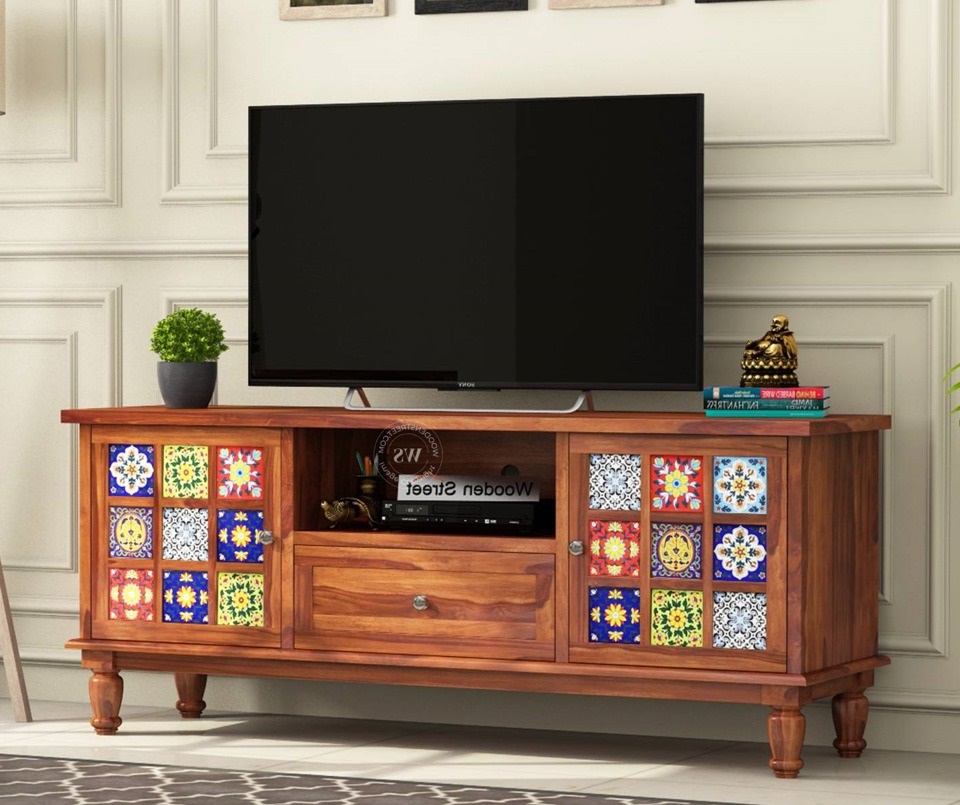
Wooden TV Stands
Wood is commonly used as the primary material for making furniture. TV stands made of wood are durable and compatible with a variety of room designs in a house.
Moreover, wood provides longer durability and good quality. However, if you have a small room, a wooden TV stand may not be the best fit due to its solid appearance. It is more suitable for larger rooms.
Additionally, wooden TV stands require maintenance to preserve their appearance and prevent them from looking dull. Periodic re-varnishing is necessary after several years of use to keep the TV stand looking new.
How do you go about selecting the right type of wood material?
To accomplish this, you can inquire with the seller about the different wood types they use and also observe the visible wood texture. Each wood type has a distinct texture; for instance, teak wood displays a unique texture and various clearly visible patterns.
In addition to solid wood, you can use plywood materials, which are commonly used by manufacturers to make TV tables. This type of wood is a factory-produced material and the downside is that it’s not as sturdy as solid wood. However, TV tables made of this wood type are more affordable, making them popular among many customers.
If you opt for a thin wood type for your TV table, you will need to regularly maintain its quality. Clean the thin wood TV table every day using a dry cloth.
Avoid placing it in damp areas, as mold can develop if the TV table is exposed to moisture.
Glass TV Table
Another option is a glass TV table, which is quite favored by consumers in the market.
There are two commonly used types of glass for making TV tables. Firstly, there’s clear glass, and secondly, there’s colored or ornamented glass. Clear glass is suitable for various room settings, while ornamented glass can enhance the room’s aesthetics.
The advantage of using glass material is the ease of cleaning, requiring only a wet cloth for regular maintenance. However, glass TV tables carry a risk of breaking and are not as strong as wooden TV tables, posing a potential danger, especially in households with active children.
TV Table Combination of Wood and Glass
There’s also a choice of TV table that combines wood and glass, offering a variety of designs from modern to ethnic styles.
The advantage of this type of material lies in its appearance, making it suitable for enhancing the room’s interior.
When caring for this material, pay attention to the components made of wood and glass. Use a dry cloth to clean the wood, and a wet cloth for the glass parts.
Plastic TV Table
For those with budget constraints, a plastic TV table can serve as an alternative. While not very popular or in high demand, this type of material is perfect for minimalist rooms due to its space-saving nature.
Minimalist TV Table Model with Drawers
If you desire a neater-looking TV table, consider one with additional drawers.
This TV table model typically features small drawers at the bottom, providing storage for various books or important items.
Simple Model TV Stand with Bookshelf
Television is a common entertainment feature in most Indonesian households. TV stands are essential furniture pieces to hold the TVs and can also serve to create a specific ambiance or functionality. They can convey a sense of luxury, elegance, minimalism, or other impressions, and are utilized for more than just holding the television, often serving as places to store books and other items. Choosing the right TV stand is crucial.
So, how can you select the most suitable TV stand according to your preferences?
Here is some guidance for your consideration.
If space is limited, consider the capacity when choosing a TV stand.
Some TV stands come with drawers and shelves, making them ideal for placement in bedrooms or family rooms. The storage units in these TV stands can be utilized to store various items such as CDs.
Another type of TV stand is a TV rack, which is great for saving space, especially if you have a small room.
While it may not offer as much storage space, a TV rack can significantly save space in the room.

Wooden TV Stand
Wood is a primary material for making furniture and is commonly used by manufacturers. It is versatile and can complement various room designs in the house.
Moreover, wooden TV stands offer long-lasting durability and quality. However, they may not be suitable for small rooms due to their size and solid appearance and require maintenance to keep them looking new.
How to choose the right type of wood?
You can inquire about the types of wood used and carefully observe the visible texture when purchasing a wooden TV stand. Different types of wood have distinct textures, like teak wood, which has a unique pattern and texture.
Additionally, plywood is a widely used material for making TV stands. While not as strong as solid wood, plywood TV stands are more affordable, making them popular among many customers.